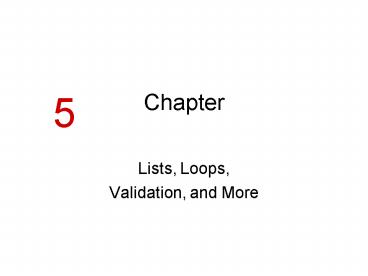Lists, Loops, - PowerPoint PPT Presentation
1 / 18
Title:
Lists, Loops,
Description:
This chapter covers the Visual Basic looping statements. Do ... While. Do ... Until ... This property holds the entire list of items from which the user may choose ... – PowerPoint PPT presentation
Number of Views:54
Avg rating:3.0/5.0
Title: Lists, Loops,
1
Chapter
5
- Lists, Loops,
- Validation, and More
2
Introduction
- This chapter covers the Visual Basic looping
statements - Do While
- Do Until
- For Next
- It also discusses the use of
- List Boxes
- Combo Boxes
- As well as presenting some properties and events
used for user input validation
3
5.1
- Input Boxes
Input Boxes Provide a Simple Way to Gather Input
Without Placing a Text Box on a Form
4
Format of the InputBox Function
InputBox(Prompt ,Title ,Default ,Xpos
,Ypos)
- Prompt - message to the user (required)
- Title - text for the box's title bar
- Default - default text for user's input
- Xpos - X coordinate for the box's position
- Ypos - Y coordinate for the box's position
- Square brackets around Title and following
arguments indicate these are optional
5
Sample InputBox Usage
- strUserInput InputBox("Enter the distance.", _
"Provide a Value", "150") - If the users clicks OK without entering a value,
150 will be assigned to strUserInput due to the
default value
6
Xpos, Ypos, and Twips
- Xpos specifies the distance from the left of the
screen to the left side of the box - Ypos, from the top of the screen to the top of
the box - Both are specified in twips
- One twip is 1/440th inch
7
5.2
- List Boxes
List Boxes Display a List of Items and Allow the
User to Select an Item From the List
8
ListBox Items Property
- This property holds the entire list of items from
which the user may choose - The list values may be established at run time or
as part of the form design - To set list values in the form design
- Select the list box in the Design window
- Click on ellipses button for the Items property
- This property is a collection, a list of values
- Type each value on a separate line
9
ListBox Items.Count Property
- This property holds the number of items that are
stored in the Items property - Example of use
- The number of items in the list can be assigned
to an integer variable
If lstEmployees.Items.Count 0
Then MessageBox.Show("The list has no
items!") End If
numEmployees lstEmployees.Items.Count
10
Item Indexing
- The Items property values can be accessed from
your VB code - Each item value is given a sequential index
- The first item has an index of 0
- The second item has an index of 1, etc.
- Example
name lstCustomers.Items(2) ' Access the 3rd
item value
11
Index Out of Range Error
- The index of the last item is always
list.Items.Count-1 - Reference to an index greater than Count-1 or
less than zero throws an exception - An exception handler can trap this error
- The variable ex captures the exception thrown
Try strInput lstMonths.Items(n).ToString() Catc
h ex as Exception MessageBox.show(ex.Message) End
Try
12
ListBox SelectIndex Property
- Use the SelectIndex property to retrieve the
index of an item selected by the user - If no item is selected, the value is set to -1
(an invalid index value) - Can use SelectIndex to determine if an item has
been selected by comparing to -1 - Example
If lstLocations.SelectedIndex ltgt -1
Then location lstLocations.Items(lstLocations.S
electedIndex) End If
13
ListBox SelectedItem Property
- Instead of using the SelectedIndex property as
follows - The SelectedItem property can be used to retrieve
a selected item value as shown
If lstMonths.SelectedIndex ltgt -1 Then month
lstMonths.Items(lstMonths.SelectedIndex) End If
If lstMonths.SelectedIndex ltgt -1 Then month
lstMonths.SelectedItem.Value) End If
14
ListBox Sorted Property
- Sorted is a boolean property
- If true, causes the values in the Items property
to be displayed in alphabetical order - If false, values in the Items property are
displayed in the order they were added
15
ListBox Items.Add Method
- Items can be added to the end of a ListBox list
in your VB code using the Add method - Format is
- ListBox.Items.Add(Item)
- ListBox is the name of the control
- Item is the value to add to the Items property
- Example
lstStudents.Items.Add("Sharon")
16
ListBox Items.Insert Method
- Items can be added at a specific position of a
ListBox in VB code using the Insert method - ListBox.Items.Insert(Index, Item)
- Index specifies position where Item is placed
- Index is zero based similar to SelectedIndex
property - Items that follow are pushed down
- Example inserting "Jean as the 3rd item
lstStudents.Items.Insert(2, "Jean")
17
ListBox Methods to Remove Items
- ListBox.Items.RemoveAt(Index)
- Removes item at the specified index
- ListBox.Items.Remove(Item)
- Removes item with value specified by Item
- ListBox.Items.Clear()
- Removes all items in the Items property
- Examples
lstStudents.Items.RemoveAt(2) remove 3rd
item lstStudents.Items.Remove(Jean) remove
item Jean lstStudents.Items.Clear() remove all
items
18
Other ListBox Methods
- ListBox.Items.Contains(Item)
- Returns true if Item is found in the collection
- ListBox.Items.IndexOf(Item)
- Returns an integer with the index position of the
first occurrence of Item in the collection - Examples
- Tutorial 5-1 provides more examples of ListBox
controls, methods and properties
blnFound lstMonths.Items.Contains(March) intIn
dex lstMonths.Items.IndexOf(March)































